Our goal is to provide you with the knowledge to help prevent frost from damaging your plants and shrubs this winter season. While you may already know that even a light freeze can affect fragile plants, a hard freeze can is likely to damage your hardiest plants and shrubs. In North Texas, we face challenges with frost most prominently in both the early spring and the fall. My mother has always said, “don’t plant in the spring until after Easter.” This timing helps avoid a late freeze in the spring damaging your newly planted flowers.
What is Frost Damage, and What Does it Look Like?
Frost damages plants by freezing the water inside of them. When ice crystals form, they will break the cell walls. Once the weather warms up, the frozen fluid inside the plants will then thaw and leak out. The leaves and stalks will then darken, turning black to brown and completely dry out as the plants die.
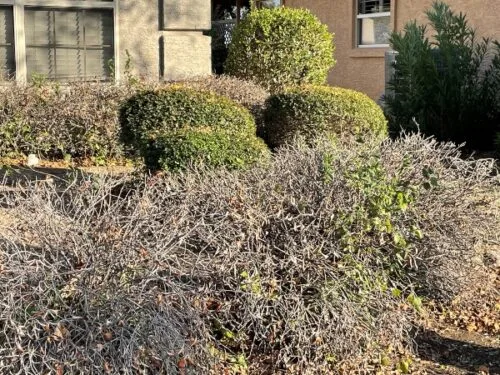
How to Protect Shrubs and Other Plants from Frost?
First, determine if you need frost damage protection for a brief period, like a light overnight freeze warning or for a more severe freeze extending over several days. Knowing the severity and length of the freeze will help you prepare. The goal is to keep the frost from freezing on your plants. The weather in the Dallas-Fort Worth metroplex, and the rest of North Texas, present challenges with keeping your plant protected during freezes. Big temperature swings and wind are two significant challenges to keeping your plants protected during a freeze.
There is an adage, “if you don’t like the weather in Texas, just wait and it will change” – sometimes within the hour! It is common for fall temperatures to range from the low thirties to seventy degrees on the same day! Strong wind, which we frequently experience in the fall and spring, can blow the frost protective covers off your plants, exposing them to frost damage. See more about how to deal with these challenges below.
Does Spraying Plants with Water Prevent Frost Damage?
You can prevent frost damage by applying a light mist of water just before and during freezing temperatures. Water holds heat and acts as an insulator. However, this frost protection technique is not very practical because most irrigation systems will not deliver a light mist and running the water all night could get expensive. Also, if the frost becomes a hard freeze, the water will freeze and not offer any protection. It is much easier to protect your plants by covering them or moving potted plants inside.
What Temperature to Cover Plants?
A light freeze is in the range of twenty-nine degrees to thirty-two degrees. Wind chill can cause the temperatures to drop below freezing even if the posted temperature may be reading above freezing. Also, remember warm air rises, so lower lying areas of your yard are more susceptible to frost. To be safe, it does not hurt to cover more fragile plants in these areas at thirty-nine degrees or less to prevent frost damage.
Plants also lose heat faster than air when it is cold. Frost can occur when the air temperature is still above freezing. To illustrate this point, place your hand on a piece of metal outside on a chilly night, like a car fender or metal pole. When the air is cold, the surface of the metal will be colder than the air because the metal loses heat faster.
A hard freeze is a temperature below twenty-eight degrees. These conditions will destroy many types of plants. Be sure to have your frost covers on your plants before dark to help your plants trap the day’s heat from the soil before it cools. This small step will help plants stay warmer during the night in a hard freeze.
What Plants to Cover in a Freeze Warning?
If you are only expecting a light freeze, take care to cover your begonias, bougainvillea, canna, hibiscus, impatiens, lantana, rose moss, primrose, snapdragons, vinca, and similar plants to prevent frost damage.
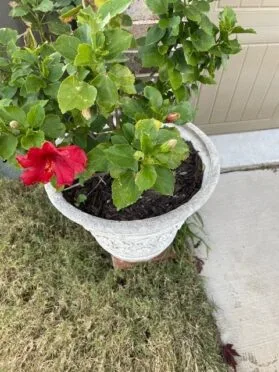
In the event of a hard freeze in the DFW metroplex or surrounding areas, cover boxwoods, wax leaf Ligustrum, pittosporum, pampas grass, viburnum, gardenias, and oleanders. In February of 2021, a vast number of shrubs were severely damaged or killed during the severe freeze in Texas. While typically these shrub varieties are hardy and usually have no problem surviving a hard freeze, this historic storm was an exception. Better safe than sorry, protect your annuals, perennials, and shrubs before a hard freeze.
Hard Freeze Damage to Shrubs on North Texas Lawn February, 2021

How Long Can You Leave Plants Covered?
Remove frost covers from your plants and shrubs when the weather warms up during the day, so they do not overheat from the heat trapped under the cover. Try not to keep plants covered for more than two consecutive days. Blocking the sunlight for more than a couple of days can cause additional damage to the plant. If you use plastic material for a cover, condensation can build up underneath and cause frost damage when freezing temperatures re-occur.
Will Frost Damage Grass?
Frost can damage grass if you have mowed the yard within a day or two before the frost. It is important that you do not mow your turf grass within two to three days of an expected freeze. It is best to stop mowing your lawn in North Texas when it starts to go dormant in the fall. Leave your grass about two to two and a half inches long at your last mowing. This will provide a layer of winter insulation for the root system.
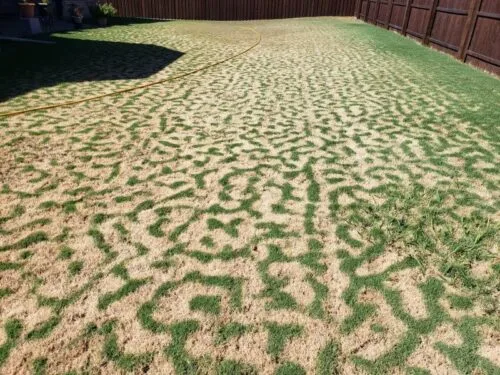
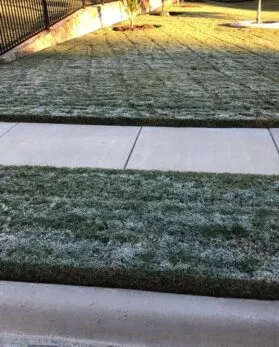
Top 5 Ways to Protect Your Plants from Frost Damage
- Water your plants a day or two ahead of a potential freeze. If any of your plants are suffering from drought stress, a drink of water will make them healthier. Water also holds heat well, acting as an insulator and helps protect them on a night with a light freeze.
- Cover plants before dusk to hold in the heat absorbed by the plant and the soil during the day. If you use a tarp, be sure to stake it down, so the wind does not blow it off the plants. Plant covers for frost protection are available at home improvements stores and online.
- Tarps, sheets, or beach towels can be practical plant covers. However, plastic tarps will transmit cold air to the plants causing more harm than protection. Use weights like rocks or bricks to hold down the corners on windy nights. Double your sheets for a thicker insulating layer of protection from frost.
- Cardboard boxes and plastic buckets can cover plants and protect them from frost if the plant fits underneath them. We recommend placing a bring or rock on top of the cover to keep the North Texas winds from blowing it over.
- Bring potted plants in to the garage or indoors. Common seasonal plants in North Texas, like hibiscus, can often be perennial if you keep them indoors during the winter. If you want these plants to appear as planted within your landscaping, insert the pots directly into your flower beds. When fall comes, you can easily remove the pots and place them in the garage or a shed for the winter. Do not forget to water them occasionally but be cautious not to overwater.
Covering your shrubs and plants during freeze warnings will prevent frost damage. This will help keep your landscape looking for many years to come. Let Weedex Lawn Care help keep your yard healthy year-round. In addition to our regular weed control and lawn fertilization, we also offer specialized services for your yard. Our ornamental tree and shrub program includes treating your plants throughout the year. This service is customized for the specific plants and ornamental trees in your landscape.
Interested in our lawn care programs? Call (972) 727-9207 for a fast, free phone quote.

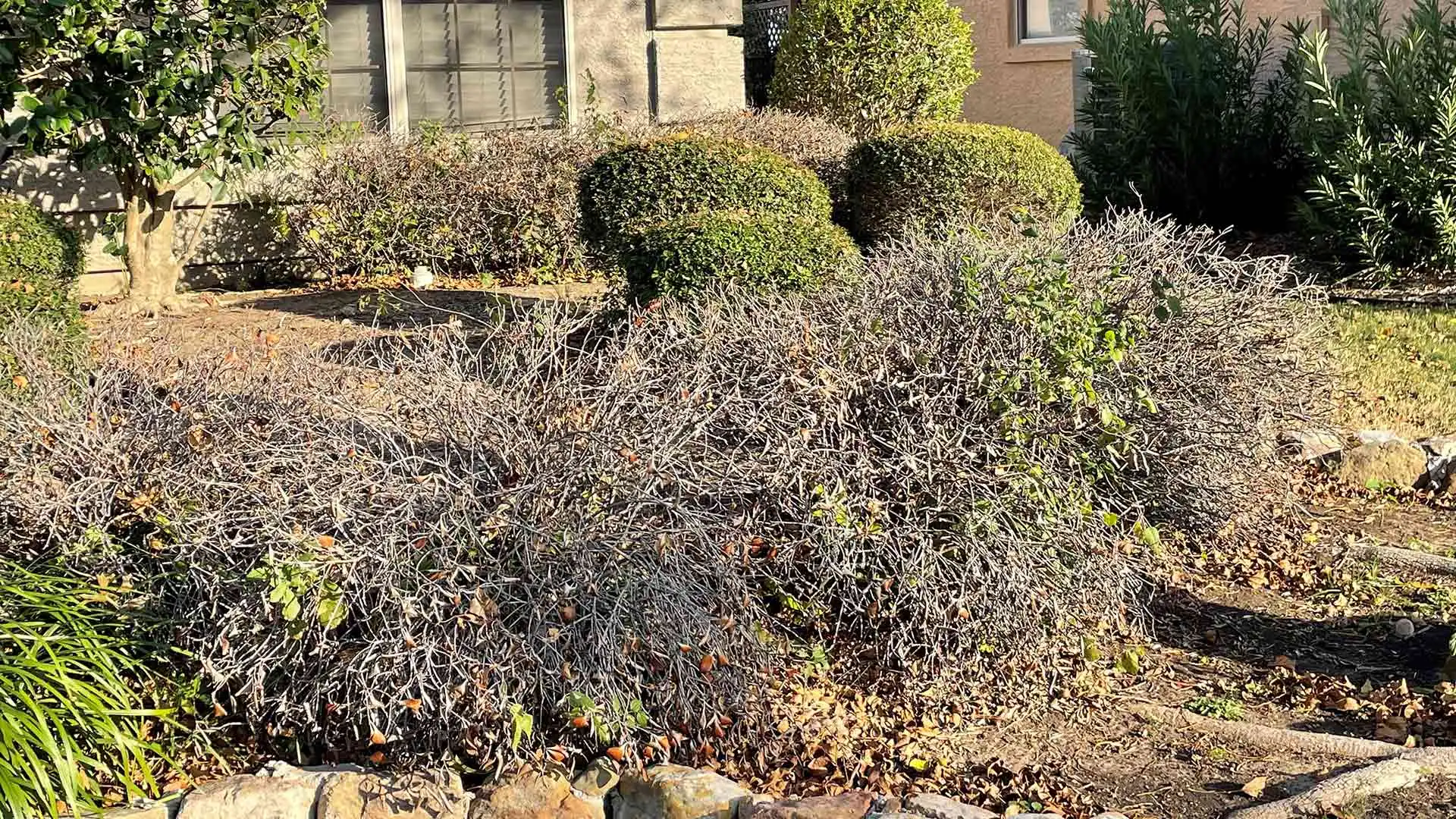

Comments (0)
Thanks for your comment!
Thanks for your feedback! Your comments have been successfully submitted! Please note, all comments require admin approval prior to display.
Error submitting comment!
There is a problem with your comment, please see below and try again.